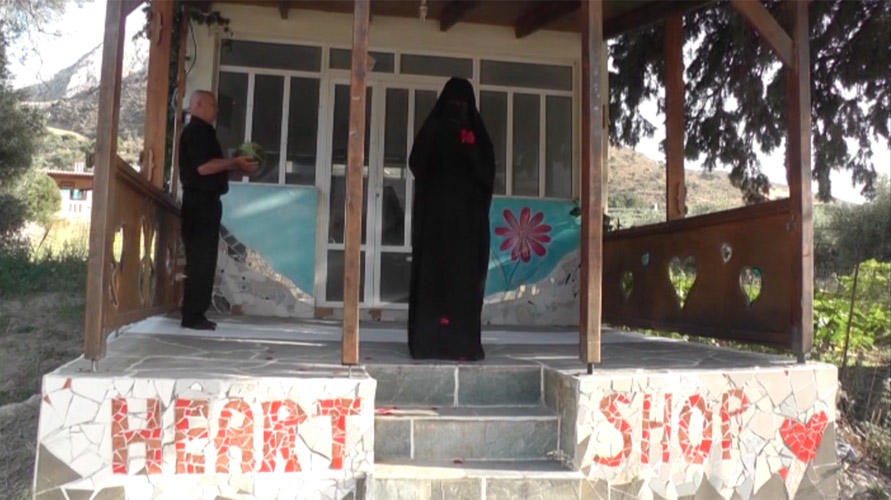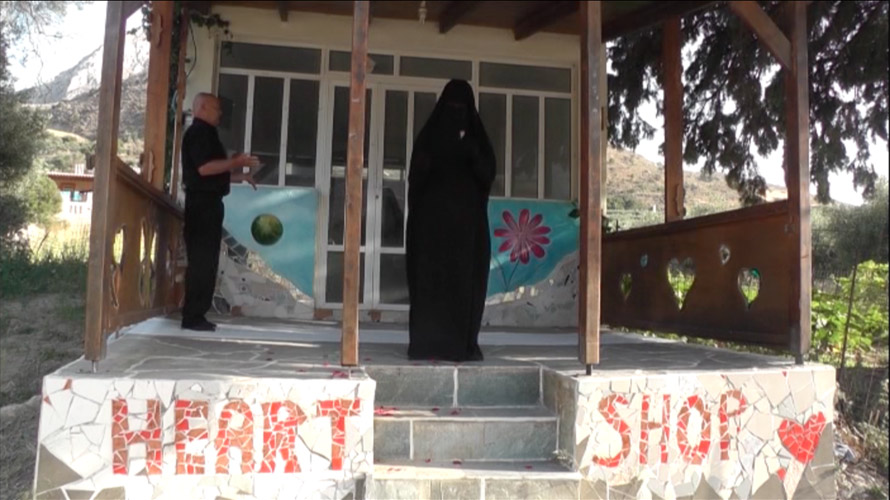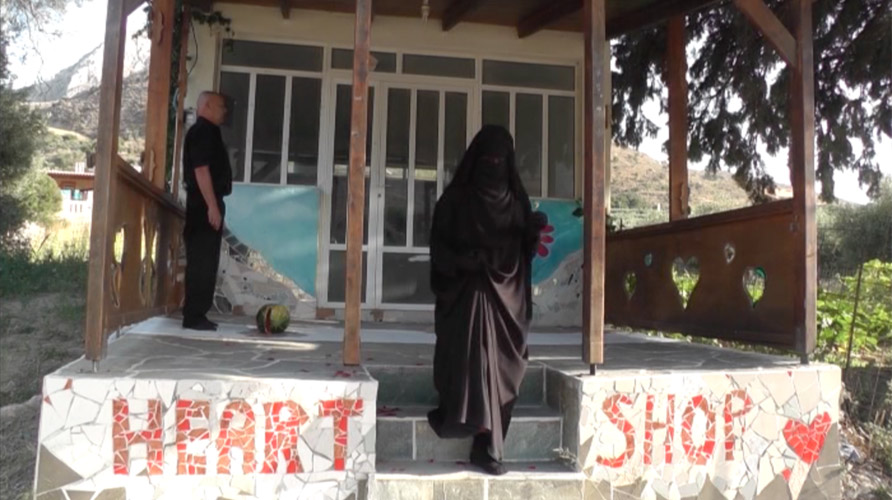


| *works << >> |
NEQAB / ST. CHRISTOPHEROS (video 6'26'' / Crete, June 2013) |
watch the video >> |
| Background
text to
NEQAB works > A small chapel located in the midst of a rocky mountain is visible. A woman dressed in a Neqab slowly walks along the winding roads from the distant summit onto a leveled road that leads past the chapel. Eventually, she vanishes form the picture. Then, for a moment her dark veiled head suddenly appears in a large scale in the picture. Eine kleine Kapelle inmitten eines felsigen Berges. Eine Frau im Neqab geht langsam vom fernen Gipfel den Serpentinenweg hinab, wandert auf einem ebenen Weg an der Kapelle vorbei und verschwindet aus dem Bild. Nach einiger Zeit taucht überraschend für einen Moment ihr schwarz verschleierter Kopf groß und schwarz wieder auf. |

| *works << >> |
NEQAB / FRANGOKASTELLO (video 17'06'' / Crete, June 2013) |
watch the video >> |
| Background
text to
NEQAB works > This shows a Venetian forth that was built for defense against seafaring aggressors. The tin-covered, ochre outer walls are preserved. Only the fortress’s foundation walls besides some tower rooms appear to be still standing in its interior. A woman wearing a Neqab walks through the ruins of the tower, while passing through light and shade. The pieces of fabric blow through the wind. Laster, under the open blue sky, she walks along a long, narrow road that is surrounded by high walls which completely enclose her.- A black, impersonal figure dressed in a flowing garment that completely covers her body attempts to find her way through a monotone and difficult course that is jammed by obstacles in the form of ruins. The heat of the day is perceptible. At the end, the woman stands inertly in the corner of a set of tower remains. As the sunlight falls through one of the windows, the rays appear to move along the stone wall. Ein im 14 Jh. erbautes venezianisches Kastell zur Verteidigung gegen seefahrende Angreifer. Die zinnenbewehrten ockerfarbenen Außenmauern stehen noch. Im Inneren sind bis auf wenige kleine Turmräume nur noch die Grundmauern erkennbar. Eine Frau im Neqab geht zwischen Licht und Schatten durch ein Turmgemäuer. Die Stoffschichten wehen im Wind. Später, unter offenem blauen Himmel, geht sie einen engen langen Weg zwischen hohen sie einschliessenden Mauern hin und her. - Eine schwarze unpersönliche Gestalt in wehendem, sie komplett bedeckenden schwarzen Gewand auf einem immer gleichen mühsamen, sehr beschwerlichen Hürdenlauf über Grundmauerreste. Die Hitze des Tages ist spürbar. Am Ende steht sie regungslos in der Ecke wieder eines Turmgemäuers. Der Sonnenlichteinfall durch ein Fenster wandert über die steinerne Wand. |

| *works << >> |
NEQAB / HEART SHOP (video 3'50'' / Crete, June 2013) |
watch the video >> |
| Background
text to
NEQAB works > A small, florally decorated house with a porch that is connected to stairs that lead onto the street. On the pedestal next the stairs, one can read the words “HEART SHOP” that are constructed with mosaic. A woman wearing a Neqab stands on the porch, one step away from the top of the stairs. She picks the petals off a red rose which she hold in her hand and drops these on the floor, one by one. On the porch’s lateral balustrade next to her stands a man carrying a large watermelon. As the woman drops the last rose petal to the ground, the man simultaneously lets go of the watermelon. As the watermelon strikes the ground, it bursts open, revealing its red pulp and releasing juice that spreads on the stone floor. Ein kleines blumig verziertes Haus mit Vorveranda zu der von der Strasse eine Treppe emporführt. An der Sockelmauer, neben den Stufen, steht in Mosaik geschrieben HEART SHOP. Eine Frau in Neqab steht auf der Veranda einen Schritt vor den Stufen. In der Hand hält sie eine rote Rose, deren Blüterbätter sie eine nach der anderen abpflückt und zu Boden fallen lässt. An der seitlichen Verandabrüstung neben ihr steht ein Mann, eine großen Wassermelone vor sich tragend. Mit dem letzten zu Boden gefallenen Blütenblatt der Rose, lässt er auch die Melone los. Sie platzt am Boden auf, wobei ihr rotes Fruchtfleisch sichtbar wird und ihr Saft sich über den Steinboden ergiesst. |
 |
 |
 |
| *works << >> |
NEQAB / PLAKA-WAVE BREAKERS (photos / Crete, June 2013) |
| Background
text to
NEQAB works > Heavy concrete wave breakers in the form of a tetrapod are placed on a concrete port barricade facing the open sea. The sun in the blue sky almost gives the wave breakers an almost white appearance. A figure covered in a black Niqab walks along the concrete wall that is positioned in front of the tremendous concrete wave-breakers Meerseitig an einer Betonhafenmauer sind schwere wellenbrechende Tetrapoden ebenfalls aus Beton aufgestapelt. In der Sonne vor blauem Himmel erscheinen sie beinahe weiß. Auf der Betonmauer, vor den gewaltigen Betonblocksteinen spaziert eine im Neqab schwarz verhüllte Gestalt. |

Background to NEQAB The videos and photos depicting the (Neqab) a garment covering the whole female body were created in the light of the steadily increasing power of the Muslim Brotherhood in Egypt and the worry that women may soon be forced to wear this garment in public places. The videos and fotos were created in June 2013 in Crete, the close European island to Egypt. The occasion among other things was an exhibition with performance in Munich. Rasha wrote down in a kind of diary her mournful feelings and thoughts while she was buying the clothing and during two shots. Thursday, 20 June 2013 Ataba-square, Cairo, Egypt A very lively square in Cairo, it was very hot with temperatures rising above 40°c that day. I pushed my way through the crowds, trying to find a Neqab (a black full-body and face covering worn by some muslim women) or a Khemar. (also a full body covering, but here the face is a little more free) I went in a clothes shop where all the men working there had long beards and stared at me with a distainful look in their eyes, even though I was wearing a pair of trousers, and a long-sleeved blouse that was buttoned right up to the top. „Where can I buy a Neqab?“ I asked. „Go behind this curtain, and the girls in there will help you“. I lifted the curtain and then a second (curtain). There I found some women and girls who looked at me strangely, probably because I was the first woman in the shop neither wearing a Neqab, a Khemar, or even a headscarf. I thought, perhaps I could tell them I wanted to buy a Neqab for my sister, or for a girlfriend but this was unecessary as all the women in the shop, even the customers, immediately and enthusiastically came to my aid offering their advice. The shop assistants happily made a great effort to bring me all those Nequabs, that were easy to put on. One assistant called another colleague and told her that I was going to wear a Neqab for the first time. „Bring her a model which is lightweight and easy-to-wear“ she said. Even the other customers offered help and explained how to put on such a garment. I was torn between telling the truth that the Nequab was not really for me, or pretending God had shown me the light and the right way to dress in a chaste manner instead of being 'naked'. Everybody helped me to put on the Neqab. I felt as if I´d entered a dark room. I saw people as if through a veil or several layers of thick fabric through which one can hardly see. I started sweating and could hardly breathe. I tried to bear this moment but could not, and felt like crying. I wanted to get out of the Neqab as fast as I could. My heart was pounding, I was nervous and flustered, I hastily shed the Neqab. Everyone around me was bewildered. To avoid insulting them I just said „How can you wear this when the weather is so hot?“ Nobody replied. Saturday 22 June 2013 Frangokastello, Crete The old fortress now in ruins, has witnessed many wars. Within the castle walls I put on the Neqab and stood in a corner, where I began to contemplate how I had chosen to cast myself into a dark tent or a pitch-black barrel. I thought about all the women who either choose to, or are compelled, to wear the Neqab.These women wear the Neqab because of social pressure, their family, husband, father, uncle, or because of the neighbours. I thought, how can a woman be ashamed of their own bodies which are a gift from God? Does anybody give any thought about how these women feel when walking in the streets, travelling on the underground, or sitting at their desks at work? I thought that my body is not free, so my body rejects this garment. Every drop of sweat running down my skin, beneath this Neqab, feels like tears, my body cries out against this repression, force, and imprisonment. Should I be ashamed??? Am I `haram´ (forbidden). Why did God make me this way? Ask the women and girls who either choose to, or are compelled to wear the Neqab, whether, in so doing, their bodies are happy and satisfied, or sad? All that causes me great pain, and I deeply regret it. I find that the Neqab is a veil for the mind. This garment casts my mind into darkness, and that frightens me. I am frightenend that Egypt, my country will one day force me to wear a Naqab. What shall I do? I would rather stay at home than go outside with my body imprisoned in a Naqab, as others want me to. I would rather my body be imprisoned at home than my soul within a garment. Sunday 23 June 2013 Plakias, Crete A place by the sea, where it is difficult to move. Christoph climbed some rocks to try and find the highest possible place to film the the performance. Being dressed in all my heavy clothes was weighing heavily on my soul. After he had asked me to climb on to another rock and then another higher up, my rebellious nature took over and I completely refused to take another step, because I was afraid I might injure myself. I started to think that I could not climb beyond the point where I felt safe. The search for a suitable location had taken more than an hour. Christoph tried to motivate me to climb as high and as far as possible, and jokingly quoted the female author Marina Abramovic: ´We have to die for art´ The search came to an end as we found a secluded sandy bay where we just did nothing but swimming and relaxing, untill we later found the ideal place. When we arrived Christoph found a rock which looked like a bed in the sea, but it was rough and had sharp edges, and one could not walk barefoot upon it. We stood on the edge of the rock and decided to start the performance at this point. Dressed in the Neqab, I stood with my back to the sea and my face to the shore, where people were sitting with (or even without) their bathing wear. After five minutes I started to sweat in this black dress, and I felt sadness in my body and on my skin.Once again my body began to weep. I thought to myself that I should just fall backwards into the sea and dash myself upon the jagged rocks under the water - I thought that more than once - but did not do it. I thought that I must concentrate on something else, something more pleasant. I noticed that some spectators were taking photographs of me, this figure completely covered in this black robe. I felt how Christoph was watching me from behind the camera, trying to give me the strength to endure, he too felt the deep sadness in my body and heart. I can not stand wearing this garment. These heavy feelings of sadness fill my body, heart and soul. |